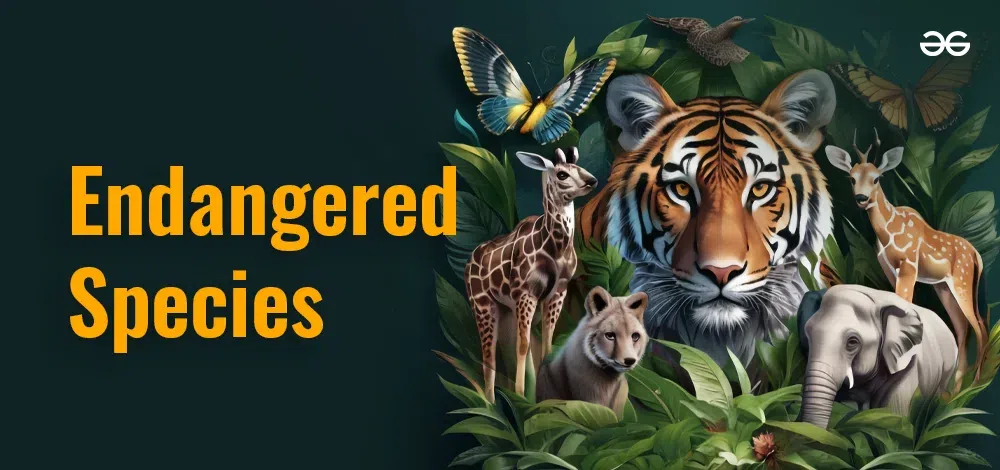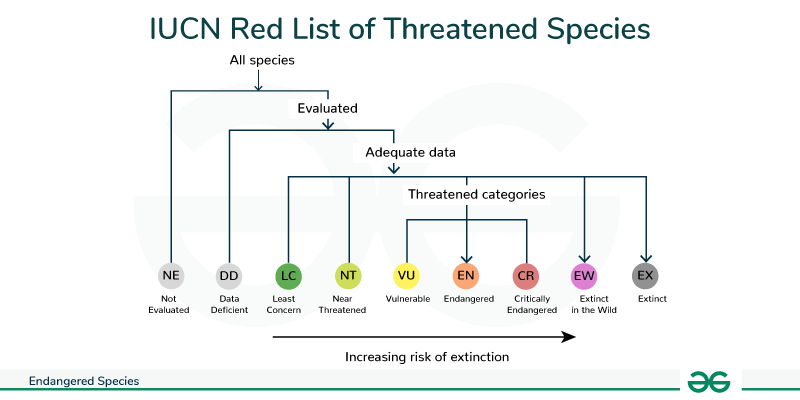
Endangered Species – Definition & List of Endangered Species
An endangered species can be a plant, an animal, or any other type of organism that is threatened by extinction. The International Union for Conservation of Nature (IUCN) keeps a Red list of threatened species. This red list is a guide that defines the specific reason and severity of the extinction of the species.
Species can be listed as endangered at the state level, federal level, or at the international level. Some endangered species examples are - the Bengal Tiger, Asiatic Lion, and Snow Leopard. In this article, we will study about endangered species in detail.

What is an Endangered Species?
Endangered species can be defined as species that are at risk of disappearing forever or threatened by extinction due to a rapid decrease in the population or sudden loss of their critical habitat.
According to the IUCN, a species is classified as an endangered species if it satisfies any of the following criteria:
- A species population size declination of ≥ 70% over 10 years or three generations and the reason is known.
- An observed or estimated species population size declination of ≥ 50% over 10 years or three generations and the reason is not known.
- The area of occupancy by species population is estimated to be less than 5000 km2.
- The population size is less than 2500 mature individuals or, estimated its extinction within the next 20 years.
IUCN Red List of Threatened Species
Every species is unique and important on its way and they should be conserved and protected. The International Union for Conservation of Nature (IUCN) is an international organization that works for nature conservation and the sustainable use of natural resources. It maintains a Red List of Threatened Species. The Red List is a widely understood and accepted system for classifying species that are at a high level of extinction.
It contains some exclusive criteria and categories to classify the individual species based on their conservation status and possibility of extinction. It is also known as the Red Data Book. The list contains several categories: Not Evaluated, Data Deficient, Least Concern, Near Threatened, Vulnerable, Endangered, Critically Endangered, Extinct in the Wild, and Extinct. In the IUCN Red List, the categories - critically endangered, endangered, and vulnerable include the threatened species.

Factors Affecting Endangered Species
The following are some of the factors affecting Endangered Species:
Species endangerment is affected by several factors. Some of them are natural factors but most are man-made factors or due to human activities. Out of those several factors some most important factors affecting endangered species are given below:
- Loss or Degradation of Habitat: Habitat loss or degradation is one of the most important factors that affect the survival of animals, plants, etc. Many species of plants and animals are becoming endangered today due to the loss of their primary habitats.
- Loss of Genetic Variation: Genetic variation is the diversity found in species and it allows them to adapt themselves according to the changing environment. The lesser the population the lesser the genetic variation.
- Chemical Pollution: Global warming and chemical pollution are also an important reason for the extinction of some species of plants and animals. For example, the declining population of amphibians, Peregrine Falcon, etc.
- Disease: The disease kills alike whether it is a human, a plant, or an animal. For example, the Ebola virus killed 5000 critically endangered western gorillas, a deadly fungus that killed 30 species of amphibians in Panam, another fungus destroyed American chestnut trees, etc.
- Overhunting or Overharvesting: For ages, this has been an important reason for species endangerment. Every time humans migrated to any uninhabited area, they hunted animals and destroyed plants & trees there and led them on the verge of extinction. A passenger pigeon is a classic example of overhunting.
- Low Birth Rate: This is a natural reason for the extinction of any species. Some species have low birth rates. They do not reproduce very often and this leads to very few offspring. Because of the lower number of offspring, they take a lot of time to sexually mature and hence will face an increased rate of extinction.
- Invasive Species: Invasive species are also an important factor that affects endangered species. They outcompete native species for land, water, habitat, and other resources and thus harm them.
Global List of Endangered Animals
Currently, according to the IUCN Red List, more than 44,000 species are threatened with extinction. This includes 41% of amphibians, 37% of sharks and rays, 36% of reef-building corals, 34% of conifers, 26% of mammals and 12% of birds.
The list of endangered species is given below:
Common Name
Scientific Name
Status
Javan Rhinos
Rhinoceros sondaicus
Endangered
Amur Leopard
Panthera pardus orientalis
Endangered
Sunda Island Tiger
Panthera tigris sondaica
Endangered
Mountain Gorillas
Gorilla beringei beringei
Endangered
Tapanuli Orangutan
Pongo tapanuliensis
Endangered
Yangtze Finless Porpoise
Neophocaena asiaeorientalis ssp. asiaeorientalis
Endangered
Black Rhinos
Diceros bicornis
Endangered
African Forest Elephant
Loxodonta cyclotis
Endangered
Sumatran Orangutan
Pongo abelii
Endangered
Pangolin
Manis sp.
Endangered
Endangered Species List in India
India is a diversified nation with numerous plants, animal species, etc. There are 89 national parks and 18 bio-reserves including 1400 animal sanctuaries. However, due to the increase in urbanization and numerous harmful human activities such as hunting, poaching, etc., the possibility of animals becoming endangered has grown.
The list of endangered species is given below:
Common Name
Scientific Name
Status
Bengal Tiger
Panthera tigris tigris
Endangered
Asiatic Lion
Panthera leo persica
Endangered
Snow Leopard
Panthera uncia
Endangered
One-horned Rhinoceros
Rhinoceros unicornis
Endangered
Blackbuck
Antilope cervicapra
Endangered
Lion-tailed Macaque
Macaca silenus
Endangered
Resplendent Tree Frog
Trachycephalus resinifictrix
Endangered
Kashmiri Red Stag
Cervus hanglu
Endangered
Nilgiri Tahr
Nilgiritragus hylocrius
Endangered
Indian Bison (Gaur)
Bos gaurus
Endangered
Effects of Endangered Species Extinction
Endangered species affect both the human and the environment. If endangered species will not be protected then it will cause severe damage to the world. For example:
- An increase in the number of endangered species will lower the world’s biodiversity.
- If a species has a unique function in its ecosystem then its absence will have a cascading effect on the ecosystem.
- Endangered species contribute to ecosystem services, such as air & water purification, carbon sequestration, provision of food and raw materials, etc. Decline in their number will affect these services.
- Endangered species also have economic value, for example in the form of ecotourism, and the decline in the number of endangered species will decrease the ecotourism which in turn harms the economy.
Conservation Efforts For Endangered Species
For endangered species conservation, various conservation efforts or laws are necessary. Many stringent rules should be made. Such as restrictions on hunting, selling, transporting, and destroying the natural habitats of species, etc. Individuals or organizations breaking these rules should be fined. Fortunately, in 1973, the United States passed The Endangered Species Act as a federal law for the protection and conservation of endangered & threatened species and their habitats.
This act covers both national/domestic and international endangered species. This was the most comprehensive legislation for the protection of endangered species. ESA prohibits the import, export, selling, possessing taking, and transporting of endangered and threatened species. It also provides the designation of habitats of endangered species as critical habitats and prohibits the destruction of that habitat. Because of these laws and legislations, many endangered species have been recovered from the endangered list. For example, the brown pelican, black-footed ferret, etc.
Conclusion - Endangered Species
The earth is the home to millions of different species. All the species including humans contribute to the normal functioning of the ecosystem. However, due to a few natural reasons and a variety of human activities, some species are at risk of extinction. To maintain the healthy co-existence between humans and nature, it is extremely necessary to enrich the earth’s biodiversity and it can be done by protecting and conserving the endangered species. Constant efforts should be made by humans to save the endangered species.
Also Read:
- World’s Most Endangered Animals
- Quite a few species of plants and animals are endangered in India
- IUCN Red List
FAQs on Endangered Species
What is an Endangered Species?
An endangered species is a species that is on the verge of extinction or at risk of extinction from the world or a particular area. For example, snow leopard, blackbuck, Asiatic lion, etc.
What are the Top 10 Endangered Animals in the World?
The top 10 endangered animals in the world are-
Javan Rhinos, Amur Leopard, Sunda Island Tiger, Mountain Gorillas, Tapanuli Orangutan, Yangtze Finless Porpoise, Black Rhinos, African Forest Elephant, Sumatran Orangutan, Hawkbills Turtles
What is the Rarest Animal in the World?
Vaquita (Phaconia sinus) is considered the rarest animal in the world and it is a type of critically endangered porpoise. It is the smallest living cetacean.
What is the Main Cause of Endangered Species?
Human activities are considered the main cause of endangered species. Out of the several human activities, habitat destruction is the primary cause of endangered species.
How many Species are on the Endangered List?
According to the International Union for Conservation of Nature (IUCN) Red List, there are around 38,500 species are under threat and more than 16,300 species are believed to be on the endangered list.
Link nội dung: https://study-japan.edu.vn/endangered-species-definition-list-of-endangered-species-a12233.html